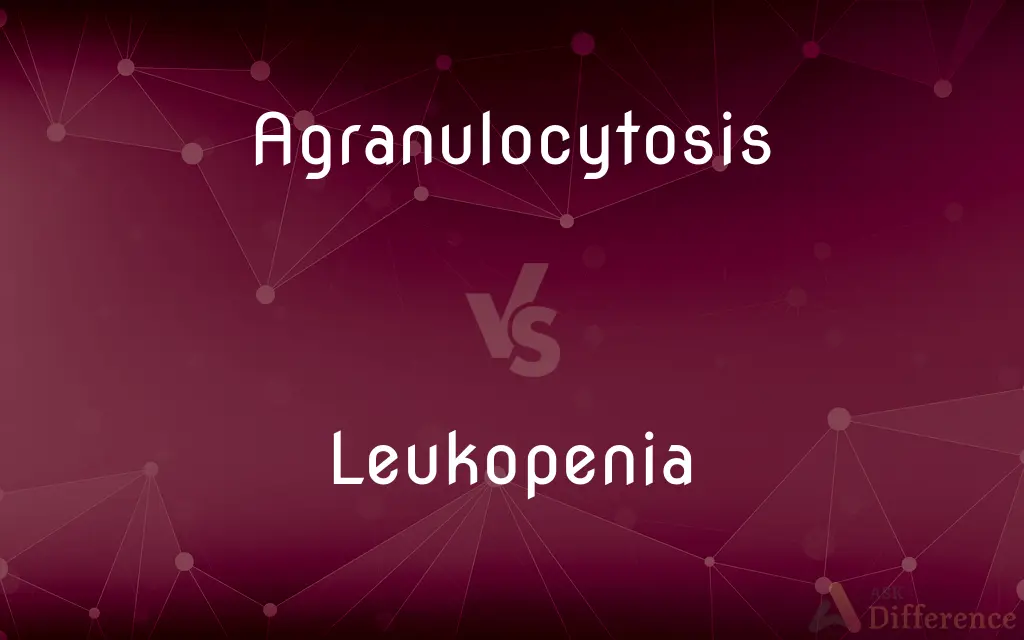Agranulocytosis vs. Leukopenia — What's the Difference?
By Tayyaba Rehman & Urooj Arif — Updated on April 19, 2024
Agranulocytosis involves a severe reduction in neutrophils, critical for infection defense, whereas leukopenia refers to a general decrease in white blood cells.

Difference Between Agranulocytosis and Leukopenia
Table of Contents
ADVERTISEMENT
Key Differences
Agranulocytosis specifically denotes an extreme decrease in neutrophils, a type of white blood cell essential for combating infections. Whereas leukopenia is a broader term that describes a reduction in the overall number of white blood cells, which includes neutrophils, lymphocytes, monocytes, eosinophils, and basophils.
Patients with agranulocytosis are particularly susceptible to bacterial infections due to the critical role neutrophils play in the immune response. On the other hand, leukopenia can result in increased vulnerability to a wider range of infections, depending on which specific type of white cells are reduced.
The causes of agranulocytosis include certain medications, autoimmune disorders, and bone marrow diseases. Whereas leukopenia might be caused by similar factors but can also occur due to viral infections that specifically target other types of white blood cells like lymphocytes.
Treatment for agranulocytosis often involves cessation of the causative drugs and administration of granulocyte colony-stimulating factor to stimulate neutrophil production. On the other hand, treatment for leukopenia depends on the underlying cause and might include medications to increase the overall white blood cell count or treat the specific infection.
Diagnostic procedures for agranulocytosis focus specifically on measuring the neutrophil count. Whereas in leukopenia, a complete blood count is essential to identify which specific subsets of white blood cells are decreased.
ADVERTISEMENT
Comparison Chart
Definition
Severe reduction in neutrophils
Decrease in total white blood cell count
Main vulnerability
High susceptibility to bacterial infections
Increased risk of various infections
Common causes
Medications, autoimmune disorders, bone marrow diseases
Viral infections, medications, radiation therapy
Diagnostic focus
Neutrophil count via blood tests
Complete blood count to assess all white cells
Treatment approach
Cessation of causative drugs, granulocyte colony-stimulating factors
Treatment based on specific underlying cause
Compare with Definitions
Agranulocytosis
Diagnosed via specific blood tests.
Her blood test confirmed agranulocytosis, leading to immediate treatment adjustments.
Leukopenia
Managed based on its underlying cause.
Treating the root cause of her leukopenia helped restore her white cell levels.
Agranulocytosis
Severe drop in neutrophils in the blood.
After receiving chemotherapy, John was diagnosed with agranulocytosis.
Leukopenia
Can affect multiple types of white cells.
Leukopenia can make a person susceptible to both viral and bacterial infections.
Agranulocytosis
Often caused by adverse reactions to drugs.
Some antipsychotic drugs can lead to agranulocytosis.
Leukopenia
Monitored through routine blood testing.
His routine check-up revealed leukopenia.
Agranulocytosis
Marked by neutrophil counts extremely low.
Agranulocytosis makes patients highly prone to severe infections.
Leukopenia
General reduction in white blood cells.
Leukopenia was evident from her complete blood count.
Agranulocytosis
Requires urgent medical treatment.
He was treated with growth factors after developing agranulocytosis.
Leukopenia
Sometimes caused by viral infections or medications.
The patient's leukopenia was attributed to his ongoing medication regimen.
Agranulocytosis
Agranulocytosis, also known as agranulosis or granulopenia, is an acute condition involving a severe and dangerous lowered white blood cell count (leukopenia, most commonly of neutrophils) and thus causing a neutropenia in the circulating blood. It is a severe lack of one major class of infection-fighting white blood cells.
Leukopenia
Leukopenia (from Greek λευκός (leukos) 'white', and πενία (penia) 'deficiency') is a decrease in the number of leukocytes. Found in the blood, they are the white blood cells, and are the body's primary defense against an infection.
Agranulocytosis
An acute condition characterized by a marked decrease in circulating granulocytes, especially neutrophils, and often leading to infection. It is usually drug-induced or caused by exposure to radiation or toxic chemicals.
Leukopenia
An abnormally low number of leukocytes in the circulating blood.
Agranulocytosis
(disease) An acute condition involving a severe and dangerous leukopenia, particularly of neutrophils, causing a neutropenia in the circulating blood.
Leukopenia
(medicine) An abnormally low count of leukocytes, or white blood cells, in the blood.
Agranulocytosis
An acute blood disorder (often caused by radiation or drug therapy) characterized by severe reduction in granulocytes
Leukopenia
An abnormal lowering of the white blood cell count
Common Curiosities
What are the risks of leukopenia?
It increases the risk of infections since white blood cells are essential for immune defense.
What causes agranulocytosis?
It can be caused by certain medications, autoimmune diseases, or bone marrow disorders.
What is agranulocytosis?
A severe depletion of neutrophils, a type of white blood cell important for fighting infections.
Can leukopenia be cured?
Treatment and potential cure depend on addressing the underlying cause, which can vary widely.
How is agranulocytosis treated?
Treatment typically involves stopping the causative drugs and may include using growth factors to stimulate neutrophil production.
What is leukopenia?
A reduction in the overall number of white blood cells in the body.
What symptoms might suggest agranulocytosis?
Symptoms include sudden fever, severe infections, and ulcers in the mouth.
How is leukopenia diagnosed?
Through a complete blood count test that measures levels of various types of white blood cells.
What should one do if diagnosed with leukopenia?
Follow medical advice to treat the underlying cause and protect against infections.
How are agranulocytosis and leukopenia similar?
Both conditions involve abnormalities in white blood cell counts, leading to increased infection risks.
Is agranulocytosis more severe than leukopenia?
Yes, agranulocytosis is often more severe due to the critical role neutrophils play in fighting bacterial infections.
Can lifestyle changes help manage leukopenia?
While lifestyle changes alone cannot cure leukopenia, they can support overall health and enhance immune function.
How are agranulocytosis and leukopenia different in terms of treatment?
Agranulocytosis treatment is more specific to boosting neutrophil production, while leukopenia treatment varies according to the white cells affected.
Are there preventive measures for agranulocytosis?
Preventive measures include careful use of drugs known to cause this condition and regular monitoring of blood counts during treatment.
Can leukopenia affect children and adults alike?
Yes, leukopenia can occur in both children and adults, depending on the cause.
Share Your Discovery

Previous Comparison
Clicky vs. Clucky
Next Comparison
Define vs. ReferAuthor Spotlight
Written by
Tayyaba RehmanTayyaba Rehman is a distinguished writer, currently serving as a primary contributor to askdifference.com. As a researcher in semantics and etymology, Tayyaba's passion for the complexity of languages and their distinctions has found a perfect home on the platform. Tayyaba delves into the intricacies of language, distinguishing between commonly confused words and phrases, thereby providing clarity for readers worldwide.
Co-written by
Urooj ArifUrooj is a skilled content writer at Ask Difference, known for her exceptional ability to simplify complex topics into engaging and informative content. With a passion for research and a flair for clear, concise writing, she consistently delivers articles that resonate with our diverse audience.














































